 |
The Features of Your Job Website Page
Nearly everyone’s job website has job descriptions on it. In fact, 63.4% of job website boards feature an application form, and 61.2% include résumé delivery.
The Role of Your Job Website Page
The overwhelming majority of respondents feel that their jobs website or webpage plays at least a somewhat important role in their recruitment program. Specifically, 47.8% said that it was “an important role,” and 30.7% said it was “somewhat important.” Only 16.9% said it was “not very important.”
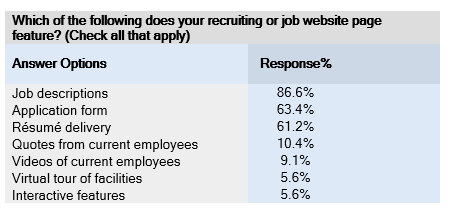 |
New Hire Orientation
The great majority of respondents (91.8%) say that they do have a new hire orientation program at their organization, 7.4% said they do not, and less than 1% said they do not know if their organization offers this feature.
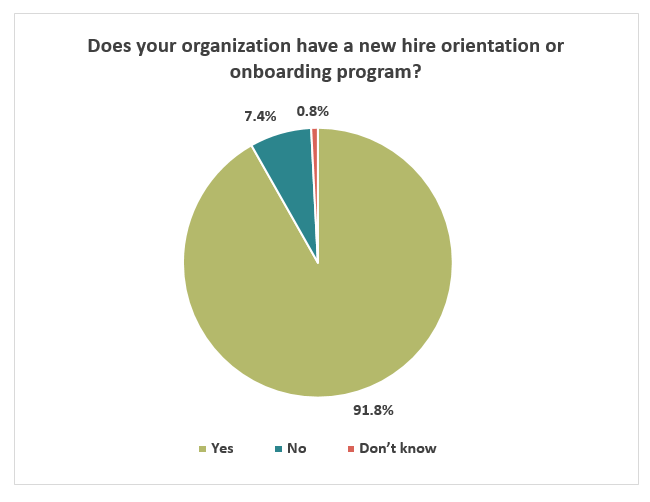 |
Length of Orientation
Participants that answered “Yes” to the previous question were asked to specify the length of their onboarding process. Answers were fairly evenly split across a number of possibilities: 20.3% said that it’s an ongoing process during the first 1–3 months of employment, 18.4% say they provide a half day of orientation, and 15.8% say they provide 1–2 hours of orientation. The least common practice (1.9%) involves a process where a teammate or manager acts as a mentor.
Occurrence of Benefit Enrollment
Most survey takers (37.0%) say that benefit enrollment occurs at the time of orientation, while 23.6% say that it occurs during the first month of employment and 16.8% say it happens during the first week of employment. Alternately, 22.5% said “other.” Some of the other responses were:
- After 30 days
- After 60 days
- After 90 days
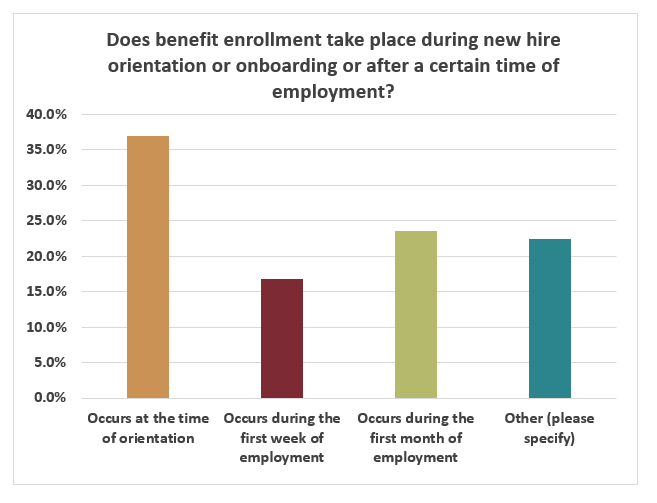 |
Management’s Role in Onboarding
When asked if management has a role to play in their company’s onboarding program, 73.4% said that they do, 23.5% said that they don’t, and only 3.1% said they didn’t know.
Management Onboarding Training
51.3% of respondents said that their management team does not receive training on how to successfully onboard new employees, 40.6% said they do receive training, and 8.1% do not.
New Employee Mentoring
When asked if their onboarding program provides mentors or buddies to new employees, 42.2 say “Yes, in addition to an onboarding process.” Only 3.6% provide mentoring to new employees instead of an onboarding process. The majority (48.8%) say “No.”
Do You Track Cost Per Hire?
Most survey takers (76.3%) do not track cost per hire. Only 23.7% say that they do.
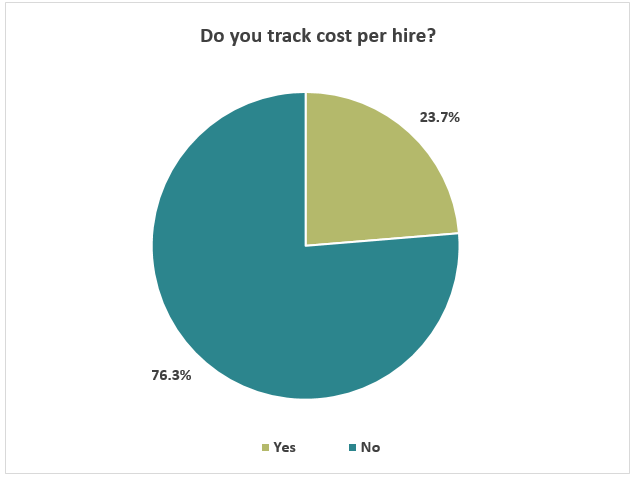 |
Average Cost per Hire
Not surprisingly, the highest cost per hire is for executives—46.6% of respondents say that executives cost at least $5,001 per hire. Senior management is the second most expensive, with 33.1% saying that they cost $2,501–$5,000 per hire. And, 37.0% of respondents say that nonexempt employees cost the least, between $0–$250 per hire.
Measuring Time to Fill
More respondents measure time to fill (41.3%) than measure cost per hire (23.7%). Still, the majority of respondents (58.7%) don’t measure this metric.
Average Time to Fill
Just as executives cost the most per hire, they also take the longest to find; 58.7% of those polled say it takes 60 days or more to fill executive positions. Also like cost-per-hire, nonexempt employees are the quickest to fill—30.1% of participants said it takes 1 to 15 days to fill nonexempt positions.
Measuring Quality of Hire
Almost one-half (43.9%) of survey takers say that they do measure quality of hire, while 56.1 say they do not.
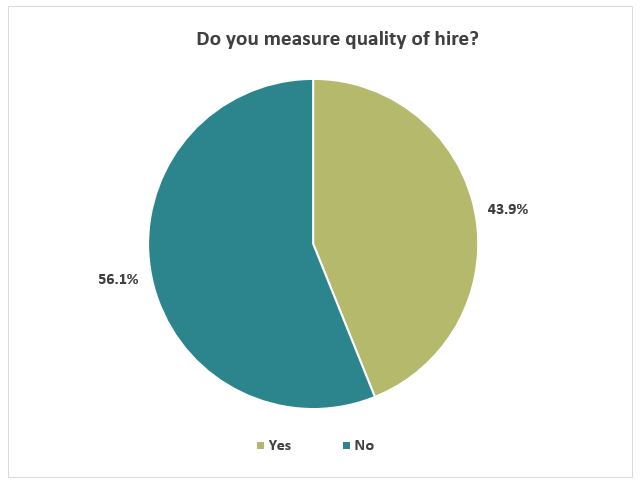 |
Quality of Hire Metrics
When asked what metrics they use to measure quality of hire, respondents overwhelmingly answered “retention” (55.0%) as their number one metric. Other methods like “hiring management satisfaction”, “average performance rating of new hires vs. standard,” and “production level of new hire after X months vs. standard” all were below 20%. Just 8.6% of participants answered “Other.” Here are some of their responses:
- All of the above.
- I don’t know.
- New hire interviews after a period of time.
- It varies based on the type of positions for which recruitment is required.
- Performance during training period and actual job performance.
Alternate Metrics
Almost one-half (49.8%) of participants say they track “offer to acceptance ration,” while 42.4% of participants say that they track applicant experience. Metrics like “interview-to-hire ratio” (35.0%) and “time to fill broken out by action, time from posting to review, time from offer to acceptance” (23.2%) also got decent percentages. The least used was “relocation costs” (13.3%).
Who Responded?
A total of 516 participants responded to the recruiting survey, representing a diverse array of industries, business types, organizational sizes, and locations. Respondents hailed from all across the United States and also from around the world. The largest group of those who responded was from the U.S. South (19.49%). The U.S. Northeast/Mid-Atlantic was second at 17.7%, and close behind was the U.S. East Central at 16.6%. The smallest segment based on location comes from the U.S. Central/Rocky Mountain/Southwest with only 8.2%.
Of those who identified themselves, the majority (61.1%) represent privately owned, for-profit companies; 20.2% are employed by nonprofits; 10.8% work in the public sector; and government organizations were represented by 7.9% of the response pool.
Respondents identified themselves as being employed in 21 different industry categories as follows:
At 53.0%, managers made up the largest portion of the respondent pool. A little less than one-third of participants (19.3%) identified as executives (i.e., VP level or higher), and staff-level employees made up 21.4% of those surveyed. The smallest group represented (at 6.2%) was composed of supervisors.
Ultimately, recruiting is a complex set of strategies. You have probably become skilled at getting the most out of popular sites such as LinkedIn and Facebook, but you run the risk only looking where everybody else is looking. Learn how to find the best talent in the hidden corners of the internet in the form of BLR’s new webinar—Cutting-Edge Recruiting Tactics: How to Stretch Your Candidate-Sourcing Skills Beyond LinkedIn and Facebook. In just 60 minutes, on Wednesday, February 17, you’ll learn everything you need to know about cutting-edge recruiting tactics.
Register today for this interactive webinar.
By participating in this interactive webinar, you’ll learn:
- The state of social sourcing right now – which sites are getting the best traction, and why
- How to develop a broader strategy – if LinkedIn stopped working tomorrow, where would you go?
- How to use employee review sites such as Glassdoor to your recruiting advantage
- How visually based sites such as Pinterest and Instagram can play a role in your search strategy
- What role up and coming content networks such as Snapchat may play
- Ways to use your corporate blog to attract and source top candidates
- How content marketing can play into your recruiting strategy
- What’s on the horizon – the next big things that could be the top tools of the future
- How you can measure your effort and results on social sites
- And much more!
Register now for this event risk-free.
Wednesday, February 17, 2016
2:00 p.m. to 3:00 p.m. (Eastern)
1:00 p.m. to 2:00 p.m. (Central)
12:00 p.m. to 1:00 p.m. (Mountain)
11:00 a.m. to 12:00 p.m. (Pacific)
Approved for Recertification Credit and Professional Development Credit
This program has been approved for 1 credit hour toward recertification through the Human Resource Certification Institute (HRCI) and 1 credit hour towards SHRM-CPSM or SHRM-SCPSM.
Join us on Wednesday, February 17, 2016—you’ll get the in-depth Cutting-Edge Recruiting Tactics: How to Stretch Your Candidate-Sourcing Skills Beyond LinkedIn and Facebook webinar AND you’ll get all of your particular questions answered by our experts.
Train Your Entire Staff
As with all BLR®/HR Hero® webinars:
- Train all the staff you can fit around a conference phone.
- Get your (and their) specific phoned-in or e-mailed questions answered in Q&A sessions that follow the presentation.
